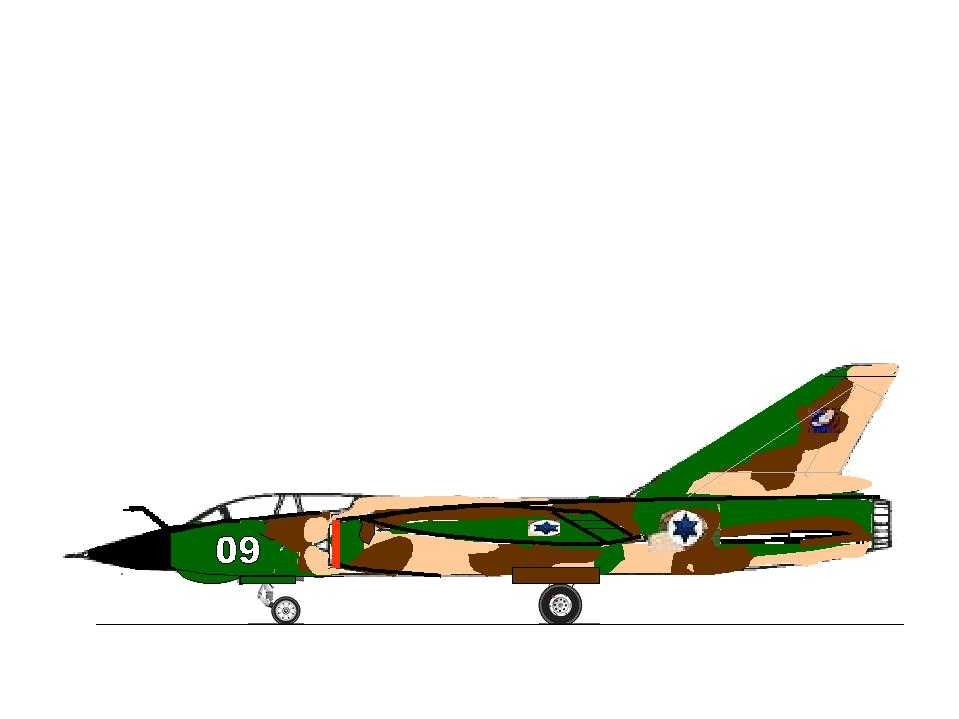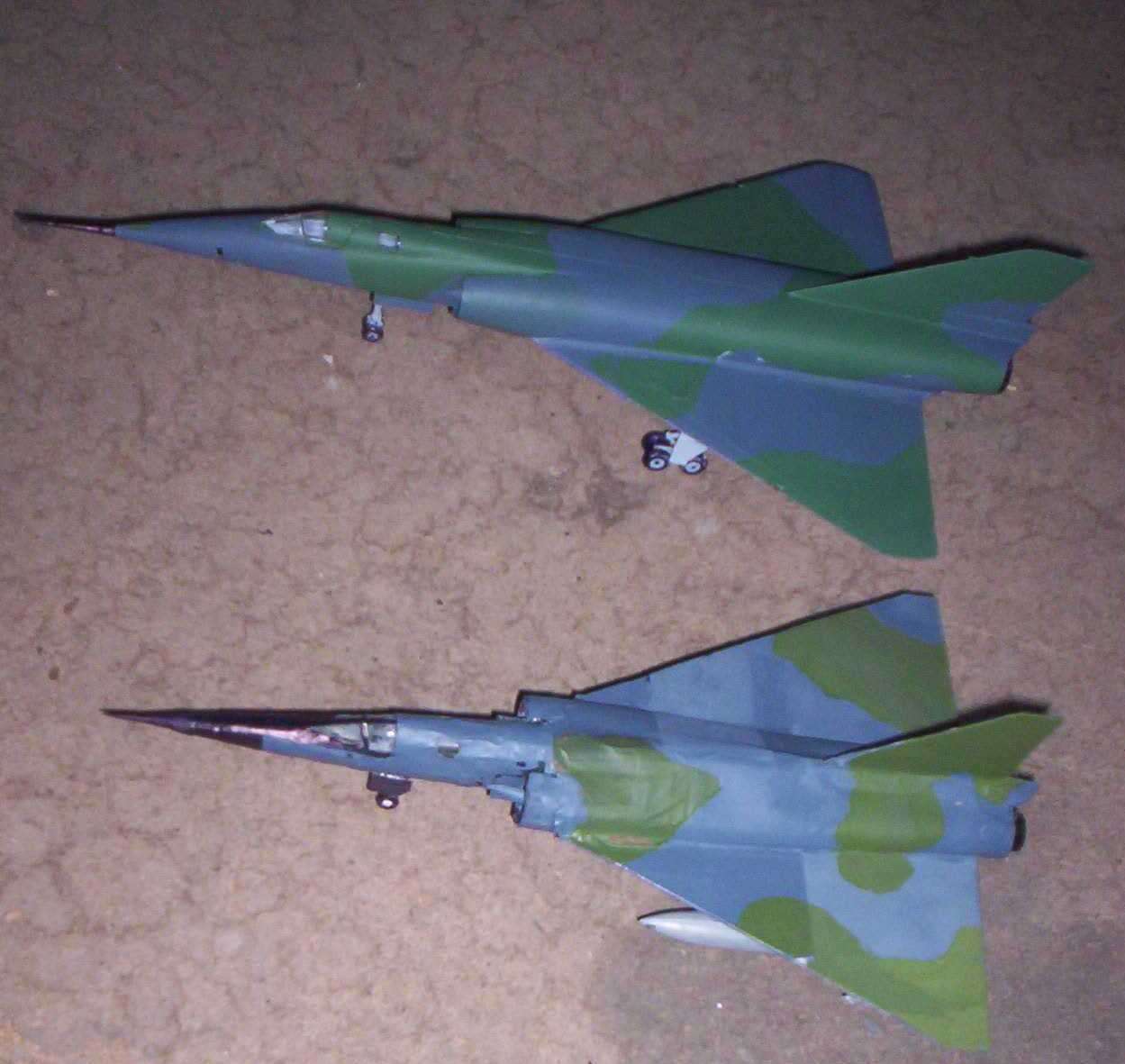Mirage IV derivatives in foreign countries
Another destiny for the Mirage IV.
So the Vautour was elected as long range nuclear strike aircraft. His escort was to be the Mirage IVC, which could also be used on the nuclear strike role, with less range. The Mirage IVC was so powerful that the idea of making a bomber of it really attracted the AdA. More, at the beginning of the 60's, many countries were interested by the Mirage IV. As a consequence, Dassault decided to make a Mirage IVA non nuclear, long range bomber, exploiting the atar 9K to its maximum. It was a private venture, but the Ada said Dassault that this aircraft could be a Vautour III replacement later.
The aircraft who flew on 17 June 1962 was a streched Mirage IVC, with atar engines of 7000kgp each. It could not carried nuclear bomb, and a conformal fuel tank was semi recessed underbelly. Many countries were interested, but disapointing by the engines (too much fuel consumption, for a limited power). After complaining to SNECMA, Dassault continued to promote his airplane.
And Great Britain started to have interest in the aircraft, as the TSR-2 -which was was much better- ran into cost, political, and delays problems. The poor TSR-2 was finally cancelled in April 1965, leaving much regrets. No time was lost by Great Britain to find him a successor : an accord was firmed on 17th may 1965 with France. The goal was to make a training aircraft starting from the Br121, and also a long range strike aircraft dubbed the AFVG. This was discuss in le Bourget airshow in june, and Dassault manage to scrap the AFVG and replacing it by its Mirage IVA. Great Britain agree, but, as many others countries, found the Mirage IVA limited by two factors : the lack of a radar following terrain in the nose, and its Atar engines. Dassault clearly agree with this statement, as he dislike Thompson CSF and SNECMA.
So he accepted the fact that British motors and engines would be much better. The British had precisely an up-to-date radar, it was the Ferranti designed for the TSR-2. As Olympus engines could not reasonably be used in the Mirage IV, Rolls Royce proposed its Spey. This was a turbofan, and had a 9500kgp thrust, much better than the atar. The plane was built in 18 months, as it was a derivative of the IVC and A. In january 1967,the first prototype was ready in Istres. Roland Beamont went to France, and meet Jean Marie Saget and René Bigand. Beamont climb on the cokpit, with Saget behind him. The prodigious skills of these pilots nearly assured the success of the first flight. The flight was unenventfull, a success. Beamont phone to the RAF and said "I've got your bird!".
The flight tests were rapidly made, and the prototype prove tremendous. It was much lighter than the F111 (the VG induced a big weight penalty, whereas the delta was much lighter),but had the same power (Spey = TF-30= 9500kgp of thrust) and a very good range. The aircraft had clearly much growth potential than the F-111, and development was surprisingly easy. The RAF was satisfied with the plane, albeit it didn't have the enormous, brute power of the TSR-2.
But the events accelerated. In june 1966, Isreal test pilot Daniel Shapira went to France, to test the Mirage F2 who just flew. He met Beamont, Bigand and Saget. Israel searched for a long range strike fighter, but Shapira was clearly dispointed by the F2. More, it had a TF-30 engine, and at the time, Israel as France could not afford that (for political reasons).
Dassault proposed Shapira to make a flight on the Mirage IVA, mentionning that a much better derivative would come soon. Shapira was impressed by the IVA, and when he came back to Israel, said the IDF/AF to change his plans. The F2 buying was scrapped, and replace by a Mirage IVK order. Waiting for that, Israel ask France a loaning of Mirage IVA for recon, and conventional bombing. The IVA production was close to an end (it stopped in october 1968) so a batch of these bombers could be loan to Israel. The country was satisfied by the loan, and this help avoiding tense relations between Isreal and France. But time was running; in April 1967, 6 Syrians MIGs were downed by Mirage IIICJ. This create an enormous tension, and Israel prepare to attack first. The loan with France was kept highly secret (as the F84F deal in 1956).

On the night of 5th may, 1967 a Boeing landed in Cyprus. It had El Al markings, but was clearly not an airliner. Minutes later, a big, delta wing aircraft landed. This was clearly a Mirage IVA, with a recon pod underbelly. French-like pilots and NOSA climb down, and explain that they went to a NATO exercise on Wheelus AFB, in Lybia. The Boeing was -heavily- refueled and took off first, then the Mirage IV followed. The same incident took place five times on the week. Cyprus ambassador asked France what happened, but De Gaulle said the same thing the pilots had said. The rumor was in full swing, but was not confirmed. On 6th may 1967, the first Mirage IVA landed on Hatzor, along with american RF4C phantoms (they come from Ramstein AFB via Moron in Spain.). A C-141 and a C-130 quickly followed, with the C-135FR. AdA and Dassault technicians started preparing the equipments. The Mirages IVA flew recon missions and 65000fts and mach2, escaping various times to MIGs just by climbing or accelerating. This airplanes were painted in the same camo as the Mirage IIICJ, with Isrealis markings; their pilots and NOSA were Israelians.

On 19th may 1967, a Mirage IV took off from Hatzor, climb to 65000fts and Mach2.2 at full power and headed to south west. Its goal: Louxor air base. The plane crossed the sinai, and entered Egyptian airspace. Right from this moment, dozens of MIG-21 interceptors tried to shoot it down all along the way. Some of then made zoom climbs, other launched Atoll air to air missiles -whithout any chance of success-!! But one of the pilots had a close look at the intruder and reported that it was "a delta wing, Mirage III-like but much bigger and with two exhausts". Its glimpse was very brief, as its MIG couldn't stay more than 10 seconds to this height. Louxor air base was mapped, but then SA-2 were launched : one of them exploded 800m behind the plane, which was shaked and slighltly crippled. The airplane quickly return to Hatzor, and landed. It was discovered that a piece of the missile was hanging below the exhaust of one Atar!!
When returning, Israelian pilot noticed that Dassault technicians looked sad : he learned that Dassault chief test pilot, René Bigand, had been killed on the crash of the first Mirage F1 prototype near Istres. A happier new was the first flight of the Mirage V on the same day; 50 of them were for Israel. The Mirage IV detachment flew dozen of missions, and return to France on 15th June 1967. One of the plane stayed with IAI for tests; the aim was to adapt bomb racks on underwings pylons, and determine the maximum bombload. This was a deep secrecy. The trouble was it was impossible to stop in Cyprus to refuel, and as consequence the airplanes flew at subsonic speed from Hatzor to Mont de Marsan, using their maximum ferry range of nearly 4000kms. As it was insufficient, a C-135 was scrambled from Mont de Marsan to refuel some of the bombers. Only 5 airplanes were parked on the base, and stripped down of their Israelian markings. They return service on the following days.
After the Six-days war, the IVK continued his test flight; the plane entered service in the RAF in september 1969, along with Sq 1 harriers. The AdA, RAAF and SAAF also bought it, instead of Vautours, F-111 or Buccaneers.But the Mirage IV would never be sold to Israel,because of the French arm embargo. Nevertheless, the Israelis made with this airplane exactly the same thing they had made with the Mirage V : steal the plans, borrow the atar engines to another country and construct 50 copies. The plane was dubbed "Raam", which means thunder in hebraic. For the second batch, the engines were replaced by J79 and local electronic systems were added. Their was also bomb racks underwings, and a conformal fuel tank under the belly… Israel had a tremendous bomber, far better than Phantom for long range, non-nuclear bombing.
So their was finally three versions of Mirage IV
- Mirage IVA/I : two Atar 9 engines, 3000kms combat range, mach 2.2.
- Miragen IVF/K/Z/O : two Spey engines, 4800km range, mach2.5
- Raam : two J79 engines, 4000km range, mach2.3.
French prototype (with Atars) was Mirage IVA. Israeli airplanes were Mirage IVI or (illegal) Raam. For South Africa, this become Mirage IVZ, Mirage IVO for Australia and Mirage IVK for Great Britain. French airplanes were Mirage IVF.
The Mirage IVK saw combat in Vietnam with the RAAF, in Angola with SAAF, in the Falkland War with the RAF and, more, during the Kippour War with the IDF/AF, where some of them were ready to ("Samson") nuke arabs countries.


